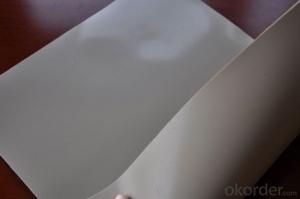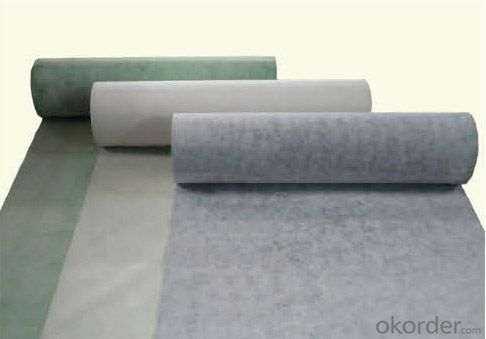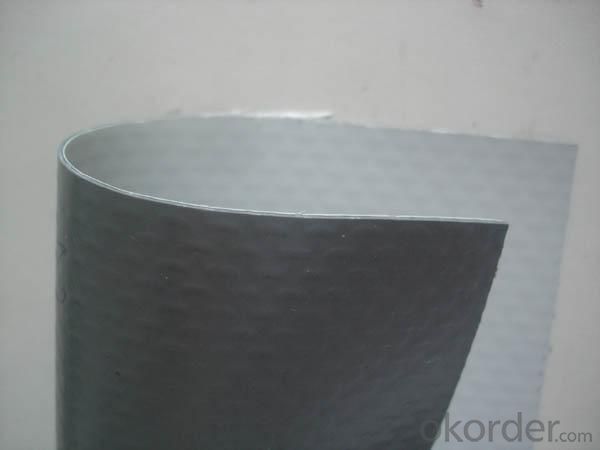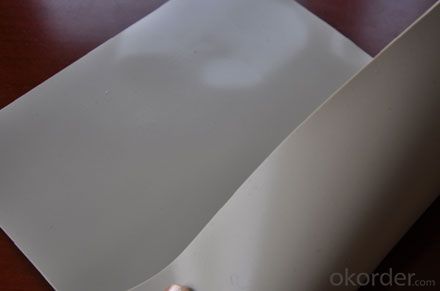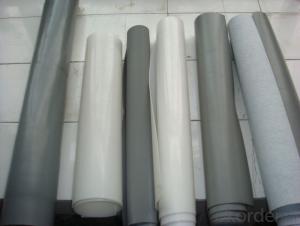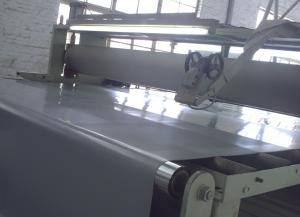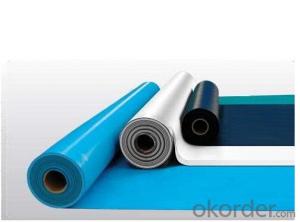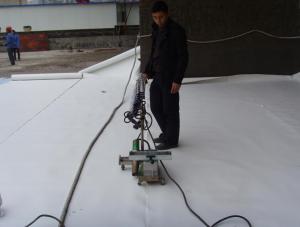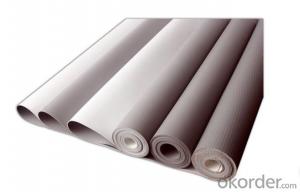PVC Roofing and Waterproofing Membrane Rolls
- Loading Port:
- China main port
- Payment Terms:
- TT OR LC
- Min Order Qty:
- 5000 m²
- Supply Capability:
- 100000 m²/month
OKorder Service Pledge
OKorder Financial Service
You Might Also Like
PVC membrane Product Description:
PVC waterproofing roofing membrane are based upon Polyvinyl Chloride Resin
with other additives to provide flexibility and stability. It gives a good performance of
anti-oxidant, absorbent of ultraviolet light, plasticizer and plastic filling agent.
Product Classification:
Product is classified by felt:
1. Product without felt
2. product with single-ply fibre
3. product with fabric reinforcement
Every type of product is classified into kind Ⅰand Ⅱbased on physical property.
PVC membrane Product Specification:
Length: 10m, 15m, 20m
Thickness: 1.2mm, 1.5mm, 2.0mm
Width: 2.05m
PVC membrane Physical Performance
Class L: Product with single-ply fibre
Class W: Product with fabric reinforcement
PVC membrane Application Range:
PVC waterproof membrane forms an effective barrier to liquid water or water vapor
in the steel structure for industrial and civil engineering, underground engineering, such as
subway, bridges , tunnel, water pools, shelter, grain depot, land filling and subway.
Products display
FAQ of PVC Waterproofing Membrane
a.Can we get some samples before place order?
Answer: We can send the free samples to you by freight collect.
b.How many years can your PVC membrane guarantee?
Answer: We will guarantee the quality for 5 years at least.
c.Which countries you ever export the product?
Answer: We export the PVC membrane to South Africa, Middle east and even European countries.
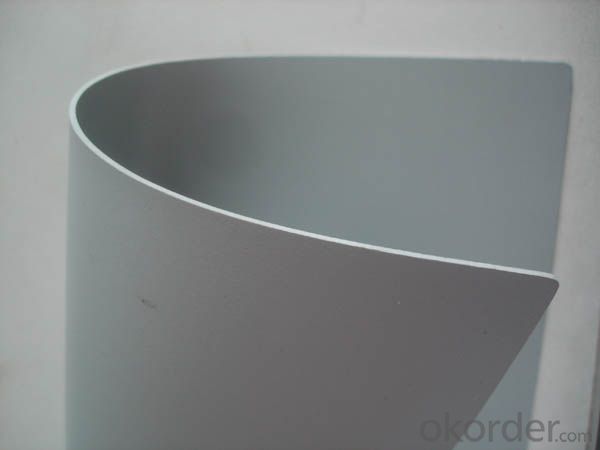
- Q: Can a waterproofing membrane be installed in wet conditions?
- Yes, a waterproofing membrane can be installed in wet conditions. However, it is important to ensure that the surface being waterproofed is dry and free of any standing water before the installation. This is because the membrane needs a clean and dry surface to adhere properly and create an effective barrier against water. If the surface is wet, it may prevent the membrane from bonding correctly, leading to potential leaks or failures in the waterproofing system. Therefore, it is recommended to wait for the surface to dry or use appropriate methods to remove any excess moisture before installing the waterproofing membrane.
- Q: Are waterproofing membranes suitable for balconies and terraces?
- Yes, waterproofing membranes are suitable for balconies and terraces as they provide an effective barrier against water infiltration, protecting the underlying structure from potential damage caused by moisture.
- Q: Can a waterproofing membrane be used in conjunction with fire protection systems?
- Yes, a waterproofing membrane can be used in conjunction with fire protection systems. While the primary function of a waterproofing membrane is to prevent water penetration, it can also act as a barrier to protect against fire. Some waterproofing membranes have fire-resistant properties, allowing them to withstand high temperatures and prevent the spread of fire. However, it is essential to ensure that the specific waterproofing membrane chosen is compatible and approved for use with the fire protection system in question.
- Q: Does a waterproofing membrane require any specialized tools or equipment for installation?
- Specialized tools and equipment are typically necessary for the installation of a waterproofing membrane. To properly install the membrane, one must utilize various common tools and equipment. These include a trowel or roller for spreading the membrane, a utility knife for cutting and shaping the membrane, a heat gun or propane torch for activating and adhering the membrane, a seam roller for ensuring proper bonding of seams, and a caulking gun for applying sealant around penetrations and edges. Depending on the specific type of waterproofing membrane being installed, additional tools such as a primer, bonding adhesive, or specialized membrane fasteners may also be required. It is crucial to refer to the manufacturer's installation guidelines to guarantee the correct tools and equipment are utilized for a successful installation.
- Q: Can a waterproofing membrane be used on gypsum board surfaces?
- Yes, a waterproofing membrane can be used on gypsum board surfaces. This membrane helps to protect the gypsum board from moisture, preventing water damage and increasing its lifespan.
- Q: Can a waterproofing membrane be used for a school building foundation?
- A school building foundation can indeed utilize a waterproofing membrane. These membranes are specifically created to safeguard structures by preventing water from infiltrating. They are commonly employed in various construction scenarios, including building foundations. By applying a waterproofing membrane to the foundation walls, it can effectively shield the building from water-related harm and prevent issues caused by moisture, such as mold, decay, and structural damage. This is especially crucial for school buildings due to their extensive foundations and the possibility of heavy usage and water exposure. Thus, the use of a waterproofing membrane is a viable solution to ensure the durability and structural soundness of the school building foundation.
- Q: Can a waterproofing membrane be used in historical or heritage buildings?
- Yes, a waterproofing membrane can be used in historical or heritage buildings. However, it is important to consider the specific requirements and sensitivities of these types of buildings before applying any waterproofing solution. Historical or heritage buildings often have unique architectural features, materials, and construction techniques that need to be preserved and protected. When using a waterproofing membrane in historical or heritage buildings, it is crucial to select a product that is compatible with the existing materials and will not cause any damage or alteration to the structure. It is recommended to consult with a professional architect or preservation expert who has experience working with historical buildings to ensure that the chosen waterproofing membrane is suitable for the specific requirements of the building. Additionally, it is important to consider the aesthetic impact of the waterproofing membrane on the building's appearance. Historical or heritage buildings often have unique architectural details and façades that contribute to their character and value. Therefore, the waterproofing membrane should be chosen carefully to ensure that it does not detract from the building's historical significance or visual appeal. In summary, a waterproofing membrane can be used in historical or heritage buildings, but it should be selected and applied with caution. It is essential to consider the building's materials, construction techniques, and aesthetic value to ensure that the waterproofing solution does not compromise the integrity or historical significance of the structure.
- Q: Can a waterproofing membrane be used on both interior and exterior surfaces?
- Both interior and exterior surfaces can benefit from the use of a waterproofing membrane. These membranes are created with the purpose of safeguarding surfaces against water infiltration and harm. Rubber, asphalt, or thermoplastic materials are commonly utilized to construct these membranes, which form a barrier to prevent moisture from penetrating. Whether applied to interior walls, floors, or exterior foundations, roofs, or balconies, a waterproofing membrane is highly effective in averting issues such as leaks, mold, or structural damage caused by water seepage. It is crucial to carefully consider the unique requirements of each surface and select an appropriate waterproofing membrane for the intended use.
- Q: Can a waterproofing membrane be used for a restaurant?
- Indeed, a restaurant can utilize a waterproofing membrane. This protective layer is employed on surfaces to impede the ingress of water. When situated in a restaurant, where copious amounts of water are employed in spaces like kitchens, dishwashing areas, and bathrooms, a waterproofing membrane can prove advantageous by averting water damage and moisture-related predicaments. It has the capability to be applied to walls, floors, and ceilings, thereby constructing a barrier against water, guaranteeing the restaurant's infrastructure's endurance and sturdiness. Furthermore, a waterproofing membrane can contribute to maintaining a spotless and sanitary environment by deterring the growth of mold and mildew, both of which are detrimental to both the establishment's structure and the occupants' health.
- Q: How to distinguish whether the waterproofing membrane is polyester tires?
- Polyester tires (polyester fabric, polyester felt, polyester linoleum fabric) with high strength, high extension and puncture resistance, light weight, high tensile strength, good permeability, high temperature, anti-freeze, anti-aging, corrosion. Technical requirements, including the appearance of quality, intrinsic quality assessment projects and internal quality reference project, the indicators are in line with the provisions of the waterproof standards. Routine project tests should be in accordance with national standards test methods, thermal stability, bending, impregnation, water resistance test methods have done a detailed test.
Send your message to us
PVC Roofing and Waterproofing Membrane Rolls
- Loading Port:
- China main port
- Payment Terms:
- TT OR LC
- Min Order Qty:
- 5000 m²
- Supply Capability:
- 100000 m²/month
OKorder Service Pledge
OKorder Financial Service
Similar products
Hot products
Hot Searches
Related keywords


